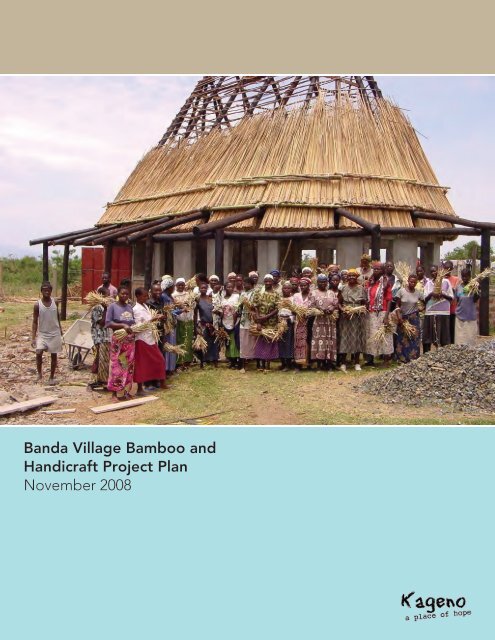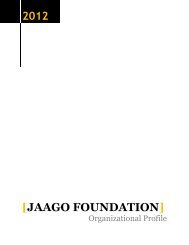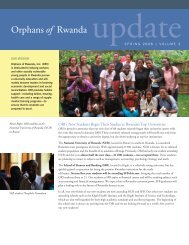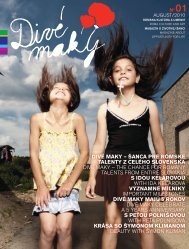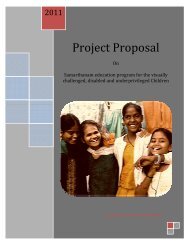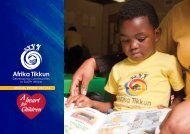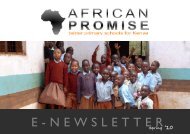Banda Village Bamboo and Handicraft Project Plan ... - GlobalGiving
Banda Village Bamboo and Handicraft Project Plan ... - GlobalGiving
Banda Village Bamboo and Handicraft Project Plan ... - GlobalGiving
You also want an ePaper? Increase the reach of your titles
YUMPU automatically turns print PDFs into web optimized ePapers that Google loves.
<strong>B<strong>and</strong>a</strong> <strong>Village</strong> <strong>Bamboo</strong> <strong>and</strong>H<strong>and</strong>icraft <strong>Project</strong> <strong>Plan</strong>November 2008
TABLE OF CONTENTSIntroduction to Kageno 2• Statement of Mission; • Statement of Vision; • Brief History <strong>and</strong> Major Accomplishments; • RapidGrowthDescription of Core Programs <strong>and</strong> Activities 4• Ventures; • Empowerment; • Education; • Health; • Clean Water; • EnvironmentIncome Generating Activities 4• Ecotourism Craft Production; • Cultural Song <strong>and</strong> Dance; • Fair Market Fishing Industry; • GoatBreeding <strong>Project</strong>; • Briquette Making <strong>Project</strong>; • OtherThe <strong>B<strong>and</strong>a</strong> <strong>Village</strong> <strong>Bamboo</strong> <strong>and</strong> H<strong>and</strong>icraft <strong>Project</strong> 6• Needs Statement; • <strong>Project</strong> DescriptionGoals <strong>and</strong> Objectives 8Evaluation Method 9• Kageno’s “Balanced Scorecard”Finances 9LIST OF ATTACHMENTSAttachment A: <strong>Project</strong> Budget………………… 10Attachment B: <strong>Project</strong> Workplan……………… 12Attachment C: Governance……………………. 14
<strong>B<strong>and</strong>a</strong> <strong>Village</strong> <strong>Bamboo</strong> <strong>and</strong> H<strong>and</strong>icraft <strong>Project</strong>Kageno Worldwide, Inc.Introduction to Kageno October, 2008INTRODUCTION TO KAGENOKageno Worldwide Inc. (Kageno) is a federally registered 501(c)(3) organization currently administeringthree comprehensive community development projects in Kenya <strong>and</strong> Rw<strong>and</strong>a from its central offices inNew York City, USA. Kageno’s flagship project on Rusinga Isl<strong>and</strong> (in Lake Victoria, Nyanza Province,Kenya) was established in 2002, <strong>and</strong> its success has helped to spark is replication on the adjacentMfangano Isl<strong>and</strong> in Kenya, <strong>and</strong> at <strong>B<strong>and</strong>a</strong> <strong>Village</strong>, in Western Province, Rw<strong>and</strong>a. These are communitiescrippled by factors including extreme poverty, lack of education, the spread of HIV/AIDS, lack of accessto safe water, rapidly deteriorating ecosystems, <strong>and</strong> genocide. To address these needs, Kageno projectshave provided centralized access to income generation; education; health services; clean water; <strong>and</strong>environmental protections.Statement of MissionKageno's mission is to transform communities suffering from inhumane poverty into places ofopportunity <strong>and</strong> hope by identifying <strong>and</strong> delivering actionable programs.Statement of VisionKageno’s founding vision was one of sustainable solutions to global poverty achieved through a set ofinterdependent programs that would address the complex web of issues faced by impoverished people. Assuch, Kageno empowers communities toward diversified economies, more educated populations, <strong>and</strong>stronger infrastructures for community health, clean water, <strong>and</strong> healthy environments (throughreforestation, preservation, <strong>and</strong> sanitation), to break cycles of poverty <strong>and</strong> allow healthier, moresustainable communities to emerge.In addition, Kageno establishes sustainability for its nonprofit programs by combining the needs-basedapproach of the non-profit sector with the entrepreneurship of successful for-profit business models. Atthe local level, microloans <strong>and</strong> well-designed small business ventures have moved individuals towardself-sufficiency. To create sustainable revenue, Kageno seeks partnerships with for-profit businesses thatcan help boost dormant revenue streams from the community’s existing environmental, cultural, <strong>and</strong>human resources.Brief History <strong>and</strong> Major AccomplishmentsIn only five years, Kageno has grown from a grassroots effort initiated in Kenya by a U.S. Peace CorpsVolunteer <strong>and</strong> a local Kenyan community organizer into a robust organization delivering communitydevelopment projects in two countries that have helped to employ 600 local people <strong>and</strong> mobilized nearly1,000 volunteers.In early 2002, the small village of Kolunga Beach on Rusinga Isl<strong>and</strong> in Kenya was in the midst of crisis.The unemployment rate was higher than 80%, with no jobs available outside of the seasonal fishingindustry. Women <strong>and</strong> girls were regularly engaged in “Fish for Sex,” avoiding starvation only byprostituting themselves to migrant fisherman in exchange for fish. Rather than attending school, childrenspent their days scavenging for food in piles of trash strewn with human feces. More than 4 in 10 peoplehad HIV/AIDS, <strong>and</strong> the village’s main source of drinking water was Lake Victoria, which receivesmillions of liters of untreated sewage each day. The village had only one latrine per 1,200 individuals <strong>and</strong>no means whatsoever to safely deposit human waste. There was no formal trash removal program, <strong>and</strong> thearea was naked of foliage after having been stripped by a population unable to afford any other form ofcooking fuel.It was in the midst of this chaos that Kageno rebuilt the infrastructure of Kolunga Beach from the groundup. Among its accomplishments on Kolunga Beach are construction of:2
<strong>B<strong>and</strong>a</strong> <strong>Village</strong> <strong>Bamboo</strong> <strong>and</strong> H<strong>and</strong>icraft <strong>Project</strong>Kageno Worldwide, Inc.Introduction to Kageno October, 2008• A nursery school where children learn in modern classrooms <strong>and</strong> receive a nutritious meal eachday;• A Voluntary Counseling <strong>and</strong> Testing Centre (VCT) that has provided HIV/AIDS testing <strong>and</strong>counseling to thous<strong>and</strong>s;• A Dispensary that has provided healthcare services to over 5000 people;• A clean water pump that delivers an ample supply of safe water to the entire village; <strong>and</strong>• 30 new latrines.Kageno has also established a formal trash collection program, planted 50,000 new trees, developedinnovative recycling programs; <strong>and</strong> implemented agro-forestry techniques to improve soil quality.Rapid GrowthKageno has proven its methodologies in its early, grassroots phase <strong>and</strong> is now transitioning into a higherimpact, more sustainable institutional phase. This exciting organizational growth has led Kageno into thenext stage of its vision – replication of successful projects. Kageno Kenya is now being replicated at twonew sites, including: (1) Kageno Mfangano (Mfangano is an Isl<strong>and</strong> adjacent to Rusinga in Kenya) <strong>and</strong>,(2) Kageno Rw<strong>and</strong>a (in <strong>B<strong>and</strong>a</strong> Cell, Rangiro Sector, Nyamasheke District, Western Province, Rw<strong>and</strong>a).These are communities that have been crippled by factors such as HIV/AIDS, extreme poverty, lack ofeducation, lack of access to safe water, rapidly deteriorating ecosystems, <strong>and</strong> genocide.Historically, Kageno has been funded mainly through a small number of private foundations <strong>and</strong> a largerbase of private donors. To maximize this phase of new organizational growth, Kageno must:(1) Increase revenue from private, public, <strong>and</strong> corporate foundations that fund nonprofit entities (tofully fund new capital projects, staffing, <strong>and</strong> program implementation).(2) Forge partnerships with for-profit entities (such as international crafts retailers, ecotourismvendors, <strong>and</strong> others) that can help to leverage some of Kageno’s early-stage Income GeneratingActivities (IGAs) into larger, more sustainable ventures. This will not only bring in revenue tosupport new growth, but also help to move communities toward self-sufficiency after Kageno’scapital projects are complete <strong>and</strong> programs are implemented.Core Programs <strong>and</strong> ActivitiesKageno has realized its founding vision by establishing six distinct but interdependent program areas:• Program Area: Ventures – Kageno’s “Ventures” program is a set of IGAs that have return-oninvestmentas the priority. Kageno IGAs in craft-production have created jobs for over 200women who weave baskets, mats, <strong>and</strong> rugs. In Kenya, Kageno has established a non-exploitivefishing business that has lifted 76 women out of prostitution. Other IGAs include a goatbreedingproject, a briquette making project (Kageno is currently producing 100 recycled trashbriquettes per day for use as an alternative to firewood as a source of fuel), <strong>and</strong> a cell phonechargingprojectProgram Area: Empowerment – Kageno’s Empowerment Program teaches the skills that make theVentures program possible. In total, Kageno has created over 600 jobs. Skills taught have led toincome generation from craft manufacturing, fishing, farming, goat breeding, <strong>and</strong> tourism. Inaddition, Kageno’s computer centers (now being accessed by approximately 400 people per month)have raised technology awareness <strong>and</strong> provided IT training, job skills, <strong>and</strong> access to information forthe whole community.3
<strong>B<strong>and</strong>a</strong> <strong>Village</strong> <strong>Bamboo</strong> <strong>and</strong> H<strong>and</strong>icraft <strong>Project</strong>Kageno Worldwide, Inc.Introduction to Kageno October, 2008Program Area: Education – The first Kageno nursery school in Kenya features modern classrooms, alibrary, <strong>and</strong> properly working latrines. Salaried teachers <strong>and</strong> a school nurse are on staff for the 200children who attend daily.∗To support the school, Kageno operatesan Orphan Assistance <strong>and</strong> SponsorshipProgram (OASP) that provides access todaily meals, shoes, bed nets, <strong>and</strong> childcounseling for all 200 of the school’schildren.Also, Kageno operates the Kageno KidsArt <strong>and</strong> Cultural Exchange, amultifaceted project connecting childrenin Kageno project areas with those inU.S. schools to exchange art <strong>and</strong> ideas.Program Area: Health – Kageno’s Dispensary <strong>Project</strong> in Kenya has provided free medical care to5000 people, including 250 orphaned children <strong>and</strong> more than 1000 mothers. Its VCT <strong>Project</strong> hastrained local volunteers to become counselors, mentors, <strong>and</strong> monitors of community health, <strong>and</strong>provided access to condoms, testing, <strong>and</strong> counseling to over 2000 people on Rusinga Isl<strong>and</strong>.Program Area: Clean Water – Without clean water, communities depend on polluted surface waterfrom nearby streams <strong>and</strong> become prone to waterborne diseases such as cholera, hepatitis, typhoid, <strong>and</strong>diarrhea. Kageno builds infrastructure for clean water delivery. Pumps are built to be cost effective<strong>and</strong> sustainable, using solar power when possible. Kageno’s two operational clean water projects (inKenya <strong>and</strong> Rw<strong>and</strong>a) now deliver an ample supply of clean water to a combined 5,000 individuals.Program Area: Environment – Since 2003, Kageno has planted over 50,000 trees, facilitated biweeklygarbage collection for 15,000 individuals, <strong>and</strong> produced 100 recycled trash briquettes per dayfor use as an alternative to firewood as a fuel source. In addition, Kageno has reduced the ratio ofindividuals to latrines from 1200:1 to 20:1, harvested water hyacinth (a common damaging weed) foruse in craft-making, <strong>and</strong> educated the community about the importance of a clean <strong>and</strong> sustainableenvironment.Income Generating ActivitiesKageno has accelerated broken rural economies through by establishing a diverse variety of creativeIGAs, including:Eco-Tourism – Starting in 2005, Kageno Kenya began offering a “<strong>Village</strong> Walk” in partnership withRusinga Isl<strong>and</strong> Lodge, an Eco-Lodge near the Kageno Kenya <strong>Project</strong>. On the walk, tourists wouldexperience Kageno’s Voluntary Counseling <strong>and</strong> Testing Centre, (where they would learn about theAIDS p<strong>and</strong>emic), see weavers at work, observe Kageno’s computer center <strong>and</strong> classes, <strong>and</strong> visit thenursery school. Authentic cultural experiences were emphasized, <strong>and</strong> ecotourism principles wereadhered to.Craft Production - Crafts programs have created over 200 jobs for women in Kenya <strong>and</strong> Rw<strong>and</strong>a.Craft projects have had an environmental impact as well, as the thous<strong>and</strong>s of baskets, mats, <strong>and</strong> rugswoven by the women are all made from water hyacinth, a destructive weed that commonly grows inAfrican waters.4
<strong>B<strong>and</strong>a</strong> <strong>Village</strong> <strong>Bamboo</strong> <strong>and</strong> H<strong>and</strong>icraft <strong>Project</strong>Kageno Worldwide, Inc.Introduction to Kageno October, 2008Cultural Song <strong>and</strong> Dance - Kageno has leveraged the incomegenerating potential of cultural traditions like song <strong>and</strong> dance aslocal people perform authentic rituals for tourists.Fair Market Fishing Industry - On Rusinga Isl<strong>and</strong>, Kageno hasestablished a non-exploitive fishing business that has takenpower away from non-local <strong>and</strong> exploitative middlemen <strong>and</strong>placed it into the h<strong>and</strong>s of local women.First, Kageno made a series of microloans to local women,which they used to purchase fish, eliminating the need to barter with sex. Second, Kageno trained afemale “fish business manager” who replaced predatory middlemen by securing current fish buyingprices (accessed through a mobile phone), <strong>and</strong> purchased the fish from the women at those prices,also using Kageno microloan funds. Then, Kageno constructed a community storage space so thatwomen could store <strong>and</strong> preserve fish safely. Throughout, Kageno provided education on personalsavings <strong>and</strong> bookkeeping to help the women pay back loans <strong>and</strong> achieve financial solvency throughthe fish trade. The fishing initiative has created 189 jobs for women, <strong>and</strong> lifted 76 women out ofprostitution.Goat Breeding <strong>Project</strong> - Kageno has worked closely with farmers <strong>and</strong> government staff to grant onegoat to clusters of four families who can support each other in breeding efforts. Offspring thencirculate among the cluster until all families have one goat. To date: 11 dairy goats have been grantedto 40 families; <strong>and</strong> 120 new goats will be born out of breeding practices per year.Briquette Making <strong>Project</strong> - Kageno has facilitated the conversion of trash into combustible briquettesthat substitute for firewood <strong>and</strong> are being be sold as an alternative form of cooking fuel. SinceJanuary 2008, Kageno has produced 100 recycled trash briquettes per day - which has recycled over4000 pounds of trash, <strong>and</strong> saved 2000 trees.Other successful Kageno ventures have included cell phone charging, renting of chairs <strong>and</strong> eventspace, <strong>and</strong> computer classes teaching valuable technical skills.5
<strong>B<strong>and</strong>a</strong> <strong>Village</strong> <strong>Bamboo</strong> <strong>and</strong> H<strong>and</strong>icraft <strong>Project</strong>Kageno Rw<strong>and</strong>a<strong>Project</strong> <strong>Plan</strong> October, 2008THE BANDA VILLAGE BAMBOO AND HANDICRAFT PROJECTIn 2008, Kageno conceived <strong>and</strong> embarked upon yet another innovative IGA at its Rw<strong>and</strong>an site: the <strong>B<strong>and</strong>a</strong><strong>Village</strong> <strong>Bamboo</strong> <strong>and</strong> H<strong>and</strong>icraft <strong>Project</strong>. This project will introduce the community to bamboo productionas a means for economic diversification <strong>and</strong> income-generation. In addition, these positive outcomes willbe tied to conservation of the nearby Nyungwe Forest, which contains nearly all of the community’srapidly depleting natural resources.As part of this project, Kageno will:(A) Partner with local builders who will learn improved building techniques through the constructionof a modern greenhouse;(B) Train 5 individual farmers on the cultivation of bamboo;(C) Train 30 women in the bamboo h<strong>and</strong>icraft production;(D) Execute a series of community workshops to increase conservation awareness; <strong>and</strong>,(E) Implement management infrastructure that will allow the community to self-manage <strong>and</strong> sustainthe project far into the future.Needs Statement<strong>B<strong>and</strong>a</strong> cell is prone to a myriad of problems related to extreme poverty <strong>and</strong> a history of war <strong>and</strong> genocide.First, this remote area contains one of the highest population densities in Rw<strong>and</strong>a, with approximately 500people per square kilometer, <strong>and</strong> historically over ninety percent of the population has been engaged insubsistence farming. This means that l<strong>and</strong> grows more <strong>and</strong> more scarce, <strong>and</strong> as there is no new l<strong>and</strong> tofarm, new earning opportunities simply run out. In addition, Rw<strong>and</strong>a’s legacy of war has all but destroyedthe area’s infrastructure, <strong>and</strong> before Kageno, <strong>B<strong>and</strong>a</strong> <strong>Village</strong> had no access to clean drinking water,HIV/AIDS was spreading rapidly, <strong>and</strong> women <strong>and</strong> children suffered disproportionately as the number ofAIDS orphans increased <strong>and</strong> local women struggled to find the means to care for them with no access toany health care facility.6
<strong>B<strong>and</strong>a</strong> <strong>Village</strong> <strong>Bamboo</strong> <strong>and</strong> H<strong>and</strong>icraft <strong>Project</strong>Kageno Rw<strong>and</strong>a<strong>Project</strong> <strong>Plan</strong> October, 2008These desperate conditions have resulted in increased dem<strong>and</strong> for the resources of the Nyungwe Forest,which is the largest remaining mid-altitude forest block in Africa, <strong>and</strong> a crucial watershed that provides towater to about 70% of Rw<strong>and</strong>a. This tropical rainforest is home to nearly 300 bird species (including 27endemic bird species), <strong>and</strong> 13 species of primates including chimpanzees, owl-faced guenons, <strong>and</strong>Angolan black <strong>and</strong> white colous monkeys living in impressive groups of more than 300 individuals. Thiswildlife population makes the area ideal for bird <strong>and</strong> primate viewing. In fact, Kageno is working anecotourism initiative for the area that when realized could become a major source of sustainable revenuefor the community <strong>and</strong> improve the quality of life in <strong>B<strong>and</strong>a</strong> dramatically - if the forest is not destroyed.Survival tactics like poaching <strong>and</strong> deforestation are devouring the forest at a non-sustainable rate, <strong>and</strong>alternatives must be found both to protect the forest’s ecosystem, its ecotourism potential, <strong>and</strong> the preservethe natural resource-based livelihoods of local people.<strong>Project</strong> DescriptionThe <strong>B<strong>and</strong>a</strong> <strong>Village</strong> <strong>Bamboo</strong> <strong>and</strong> H<strong>and</strong>icraft <strong>Project</strong> will combat these problems by providing thecommunity with the materials <strong>and</strong> knowledge needed to enter the bamboo market. <strong>Bamboo</strong> is strong,resilient, <strong>and</strong> has a wide variety of uses, making it an eco-friendly resource with the potential to drive anew, profitable <strong>and</strong> sustainable enterprise to create jobs <strong>and</strong> diversify the community’s economy. Inaddition, the production <strong>and</strong> utilization of bamboo as a building <strong>and</strong> craft making material will have apositive impact on the forest <strong>and</strong> the local environment.The project will promote conservation <strong>and</strong> a healthier environment by providing an alternative source forbuilding materials (wood especially), while teaching local people how bamboo can be used to prevent soilerosion <strong>and</strong> how to use bamboo to protect agricultural l<strong>and</strong> through the building of fences. All projectactivities will help to build a connection between the project’s positive outcomes (like income generation)<strong>and</strong> the conservation of the forest. Kageno will work closely with the Wildlife Conservation Society,which has been working in Nyungwe Forest for more than twenty years in order to better deliverconservation information <strong>and</strong> efforts.The project will be carried out in two phases:Phase 1: Identification <strong>and</strong> Material DevelopmentTwenty local builders will be taught improved building techniques as they work to construct a greenhouseunder the supervision of the Rw<strong>and</strong>an <strong>Bamboo</strong> Society. After the greenhouse is complete, the skills theylearn will be transferable to other structures through the community. Simultaneously, Kageno will consultwith the Rw<strong>and</strong>an <strong>Bamboo</strong> Society to identify an appropriate bamboo species for the area. Once a speciesis identified, Kageno will invite technicians from the Rw<strong>and</strong>an <strong>Bamboo</strong> Society to visit the site <strong>and</strong> trainfive local individuals on how to plant <strong>and</strong> grow the bamboo.Staffing for these activities will include several local <strong>and</strong> regional experts, a general manager, fourtechnical support officers <strong>and</strong> ten local builders.Phase 2: TrainingThirty women will be sent for training on the production of bamboo h<strong>and</strong>icraft products, includingfloormats, baskets, placemats, toothpicks, <strong>and</strong> skewers. They will also be trained on building (such asusing bamboo for fencing, roofs, <strong>and</strong> floors), <strong>and</strong> agricultural techniques such as soil erosion prevention.In addition, the women will be taught basic principles of business, focusing on craft productionmanagement, quality control, <strong>and</strong> marketing.7
<strong>B<strong>and</strong>a</strong> <strong>Village</strong> <strong>Bamboo</strong> <strong>and</strong> H<strong>and</strong>icraft <strong>Project</strong>Kageno Rw<strong>and</strong>a<strong>Project</strong> <strong>Plan</strong> October, 2008Goals <strong>and</strong> ObjectivesThe overarching goal of the <strong>B<strong>and</strong>a</strong> <strong>Village</strong> <strong>Bamboo</strong> <strong>and</strong> H<strong>and</strong>icraft <strong>Project</strong> is to accelerate rural economicgrowth in <strong>B<strong>and</strong>a</strong> Cell by giving the community the knowledge needed to succeed in the bamboo business,while also improving biodiversity conservation in the area by decreasing the impact on the forest <strong>and</strong> theneed for activities like deforestation <strong>and</strong> poaching.The long-term objective of the project is to develop bamboo as sustainable resource for <strong>B<strong>and</strong>a</strong> by turning itinto a cash crop for wood substitution <strong>and</strong> for h<strong>and</strong>icraft production. Once the project is fully operational,the income generated from the sale of the raw material <strong>and</strong> products will exceed the total project cost,keeping the project solvent <strong>and</strong> making its outputs sustainable.There are two primary short-term project objectives: (1) Develop a fully operational bamboo productioncenter, including a greenhouse, nursery, <strong>and</strong> distribution center; <strong>and</strong>, (2) Identify <strong>and</strong> train local women inthe production of h<strong>and</strong>icraft products. The figure below lists both qualitative <strong>and</strong> quantitative outputs forthese objectives.FIGURE 1. BANDA VILLAGE EXPERIENCE PROJECT EXPECTED PRODUCTS AND OUTPUTS1.1Products <strong>and</strong> Outputs for Objective 1 (Develop a fully operational bambooproduction center, including a greenhouse, nursery <strong>and</strong> distribution center).<strong>B<strong>and</strong>a</strong> Cell will have a more diversified range of h<strong>and</strong>icraft products to sell locally,regionally <strong>and</strong> internationally.AnticipatedTime toAchieve1 year1.2Minimized negative impact on Nyungwe National Park <strong>and</strong> the <strong>B<strong>and</strong>a</strong> community,as the planting <strong>and</strong> provision of raw materials will help the community tounderst<strong>and</strong> the importance of conservation (as opposed to the current norm of usingraw material from the forest)1 year1.3 Increased number of employment opportunities for the local community. 1 year1.3Increased numbers of locally available resources for the building of structures <strong>and</strong>the production of h<strong>and</strong>icraft products.1 year1.4 Provide 10 jobs to local builders (for the green house <strong>and</strong> l<strong>and</strong> preparation) 3 months1.5Decreased threats to biodiversity, including: wood harvesting, bushfires, mining,poaching, due to alternate employment activities, planting of raw materials, <strong>and</strong> theability of people to afford alternative fuel sources.Products <strong>and</strong> Outputs for Objective 2 (Identify <strong>and</strong> train local women in theproduction of h<strong>and</strong>icraft products)1 yearAnticipatedTime toAchieve2.1 Improved skill of local crafts producers 6 months2.22.32.4Pride in local traditions, customs <strong>and</strong> products will be promoted among residents,<strong>and</strong> greater underst<strong>and</strong>ing of those traditions <strong>and</strong> customs will be manifestedThe value of environmental conservation will be more evident to the localcommunity, <strong>and</strong> traditional <strong>and</strong> will be preservedIncreased number of skilled local individuals via the <strong>Bamboo</strong> <strong>and</strong> H<strong>and</strong>icraftProgram training.6 months1 year1 year8
<strong>B<strong>and</strong>a</strong> <strong>Village</strong> <strong>Bamboo</strong> <strong>and</strong> H<strong>and</strong>icraft <strong>Project</strong>Kageno Rw<strong>and</strong>a<strong>Project</strong> <strong>Plan</strong> October, 2008Evaluation MethodKageno will assess the degree to which its objectives have been achieved using it’s “balanced scorecard”model – which monitors individual project components in both trend form (are we getting better overtime?) <strong>and</strong> snapshot form (where are we right now relative to our annual goal?). By monitoring objectivesin this way, the scorecard guides Kageno’s allocation of resources by identifying components of theprogram, which need to be energized in order to reach the goal.Therefore, Kageno’s work will be most clearly measured on the immediate results of interventions, whichare easily measured on metrics like number of plants planted, number of community members trained, <strong>and</strong>number of products designed <strong>and</strong> produced. Placing the Kageno Scorecard at every step of the deliveryprocess helps Kageno analyze strategic decisions, <strong>and</strong> measure performance.FinancesThe total cost of the <strong>B<strong>and</strong>a</strong> <strong>Village</strong> <strong>Bamboo</strong> <strong>and</strong> H<strong>and</strong>icraft <strong>Project</strong> is S16,273. A project budget isprovided in Attachment A, on page 10.9
<strong>B<strong>and</strong>a</strong> <strong>Village</strong> <strong>Bamboo</strong> <strong>and</strong> H<strong>and</strong>icraft <strong>Project</strong>Kageno Rw<strong>and</strong>aATTACHMENTS October, 2008ATTACHMENT A<strong>Project</strong> Budget10
<strong>B<strong>and</strong>a</strong> <strong>Village</strong> <strong>Bamboo</strong> <strong>and</strong> H<strong>and</strong>icraft <strong>Project</strong>(Phase 1) Identification <strong>and</strong> Material DevelopmentItemUSDL<strong>and</strong> $ 1,849Consulting fees (including transportation <strong>and</strong> accommodation) $ 1,849Construction Materials (greenhouse) $ 5,547Labor (l<strong>and</strong> preparation <strong>and</strong> construction) $ 555<strong>Bamboo</strong> Production Training $ 370Staff (10 months) $ 925Subtotal Phase 1 $ 11,095(Phase 2) TrainingItemUSDAccommodation <strong>and</strong> transport $ 925Training cost $ 1,849Group Identification $ 370Consulting fee (management structure set-up) $ 1,849Materials (start-up materials) $ 185Subtotal Phase 3 $ 5,178Global Giving Transaction Fee 10% $ 1,627USDTOTAL PROJECT COST $ 17,90011
<strong>B<strong>and</strong>a</strong> <strong>Village</strong> <strong>Bamboo</strong> <strong>and</strong> H<strong>and</strong>icraft <strong>Project</strong>Kageno Rw<strong>and</strong>aATTACHMENTS October, 2008ATTACHMENT B<strong>Project</strong> Workplan12
BANDA VILLAGE BAMBOO AND HANDICRAFT: TIMELINE OF ACTIVITIESACTIVITYJan09Feb09Mar09Apr09May09Jun09Jul09Aug09Sep09Oct09Nov09Dec09♦ Trainings & workshops to help local community underst<strong>and</strong> theproject♦ Consulting with experts in the field <strong>and</strong> local interested parties♦ Measure impact <strong>and</strong> write detailed report on progressIdentification of species♦ Prepare the L<strong>and</strong>♦ Purchasing Building Materials♦ Construction of Greenhouse♦ Hire 10 local builder to construct the greenhouse (including anygrounds work needed)♦ 5 local individuals trained in the production of bamboo♦ Begin the incubation <strong>and</strong> production process♦ Production site fully staffed & staff members attend to daily duties♦ 30 Women train in <strong>Bamboo</strong> H<strong>and</strong>icraft Production♦ Production of small h<strong>and</strong>icraft items begins13
<strong>B<strong>and</strong>a</strong> <strong>Village</strong> <strong>Bamboo</strong> <strong>and</strong> H<strong>and</strong>icraft <strong>Project</strong>Kageno Rw<strong>and</strong>aATTACHMENTS October, 2008ATTACHMENT CGovernance14
• Frank C. Andolino, D.D.S.Kageno Co – founder, Executive DirectorPresident Boylan, Andolino & Associates• Elizabeth Ruman PlumleeKageno Vice-PresidentAttorney, MediatorKAGENO BOARD OF DIRECTORS• Louis Peter Re, MDKageno SecretaryColumbia University College of P & S, Riverside Orthopedics• Michel K. MasozeraKageno Board MemberThe Wildlife Conservation Society, Rw<strong>and</strong>a• Mary Ellen Nitti, M.P.A.Kageno TreasurerHealthcare Consultant• Elizabeth SternKageno Board Member• Damian Wey<strong>and</strong>Documentary Film ProducerADVISORY BOARD• Dr. Paul E. Farmer, M.D., Ph.DExecutive Vice President, founding director of Partners In Health• Scott ZmrhalDirector, Rosetta Marketing, <strong>and</strong> returned Peace Corps Volunteer (Kenya)• Kent BeldenEntertainmentoooPROJECT DIRECTORSAlphonce Okuku - Kageno KenyaLevi Ngilimana - Kageno Rw<strong>and</strong>aJayne Hinds Bidaut - Kageno Kids15


